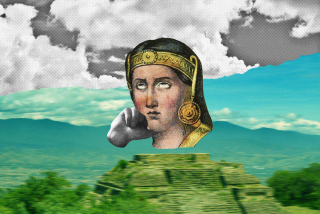DISCOVERING AMERICA
- Share via
In 1492, when Christopher Columbus arrived in what is now called North America, he wasn’t the first to discover the New World. In fact, scientists believe the first Americans traveled across an ice bridge from Asia several thousands of years ago. Viking explorers crossed the Atlantic Ocean hundreds of years before Columbus, and the wave of immigration continues to this day. Want to learn more about the discovery of America? Use the direct links on The Times’ Launch Point Web site. https://www.latimes.com/launchpoint/
LEVEL 1
The Explorations of Christopher Columbus: Learn about the voyages of the Italian explorer. Look at maps showing the routes he took, and read about what it was like to be a crew member on his ship.
https://www.mariner.org/age/columbus.html
*
Leif Ericsson: An illustrated account of how Leif Ericsson sailed to the shores of North America about 1,000 years ago. This site includes a link to the story of a modern-day crew who retraced Ericsson’s voyage in a 54-foot replica of a Viking ship.
https://odin.nls.no/viking/e/people/leif/e-leiv.htm
*
The Exploration of the Americas: A useful collection of biographies on the explorers of North and South America.
https://pen1.pen.k12.va.us:80/Anthology /Div/Albemarle/Schools/MurrayElem/ ClassPages/Prudhomme/Explorers/exploretitle.html
LEVEL 2
The Link That Binds: Learn about the Bering Strait, which scientists believe was used by ancient hunters in Asia to travel to North America. The area, now called Beringia, offers clues about the first Americans by suggesting similarities between the people, cultures, plants and animals of Siberia and Alaska.
https://www.beringia.com/02ber.html
*
The First Euro-Americans--Norse Settlers in the New World: This site gives a glimpse of the life of a Viking family in the New World and provides links to other Viking resources.
https://www.narhist.ewu.edu/ar/norse/norse.html
*
The Columbus Navigation Homepage: An in-depth look at Columbus--his crew, ships and voyages, as well as explanations of the methods and tools used by sailors to navigate ships at that time.
https://www1.minn.net/~keithp/index.htm
LEVEL 3
The Search for the First Americans: Learn how archeological discoveries provide clues to the mystery of who the first Americans were and where they originated. Read about how anthropologists use those clues to suggest possible routes for the Paleoindian migration to the Americas and what daily life was like then.
https://encarta.msn.com/downloads/archive/feb97/americans.asp
The Vikings--They Got Here First, But Why Didn’t They Stay? Maps and photos of archeological finds illustrate this discussion of the Vikings’ exploration of North America and their interactions with the Inuit tribe.
https://www.nlc-bnc.ca/north/nor-i/thule/thu-020e.htm
*
1492--An Ongoing Voyage: An exceptional site that describes the peoples and cultures of North and South America and how the arrival of Columbus and other European explorers affected them.
https://sunsite.unc.edu/expo/1492.exhibit/Intro.html
Launch Point is produced by the UC Irvine department of education, which reviews each site for appropriateness and quality. Even so, parents should supervise their children’s use of the Internet. This week’s column was designed by Stan Woo-Sam and Anna Manring.
EXPLORER’S QUEST
Free Times T-shirt
Don’t forget: Today is the deadline to pick up your free T-shirt in the Explorer’s Quest contest. If you still need an entry form, you can find it on the Launch Point Web site, https://www.latimes.com/launchpoint/
In Columbus’s first voyage, about how many miles did the ships travel each day?
Clue: Use The Explorations of Christopher Columbus
The answer to this Internet quiz can be found in the sites at right.
Answer to last week’s Quest: Two people make up a “lion” for the Lion Dance.
More to Read
Sign up for The Wild
We’ll help you find the best places to hike, bike and run, as well as the perfect silent spots for meditation and yoga.
You may occasionally receive promotional content from the Los Angeles Times.






